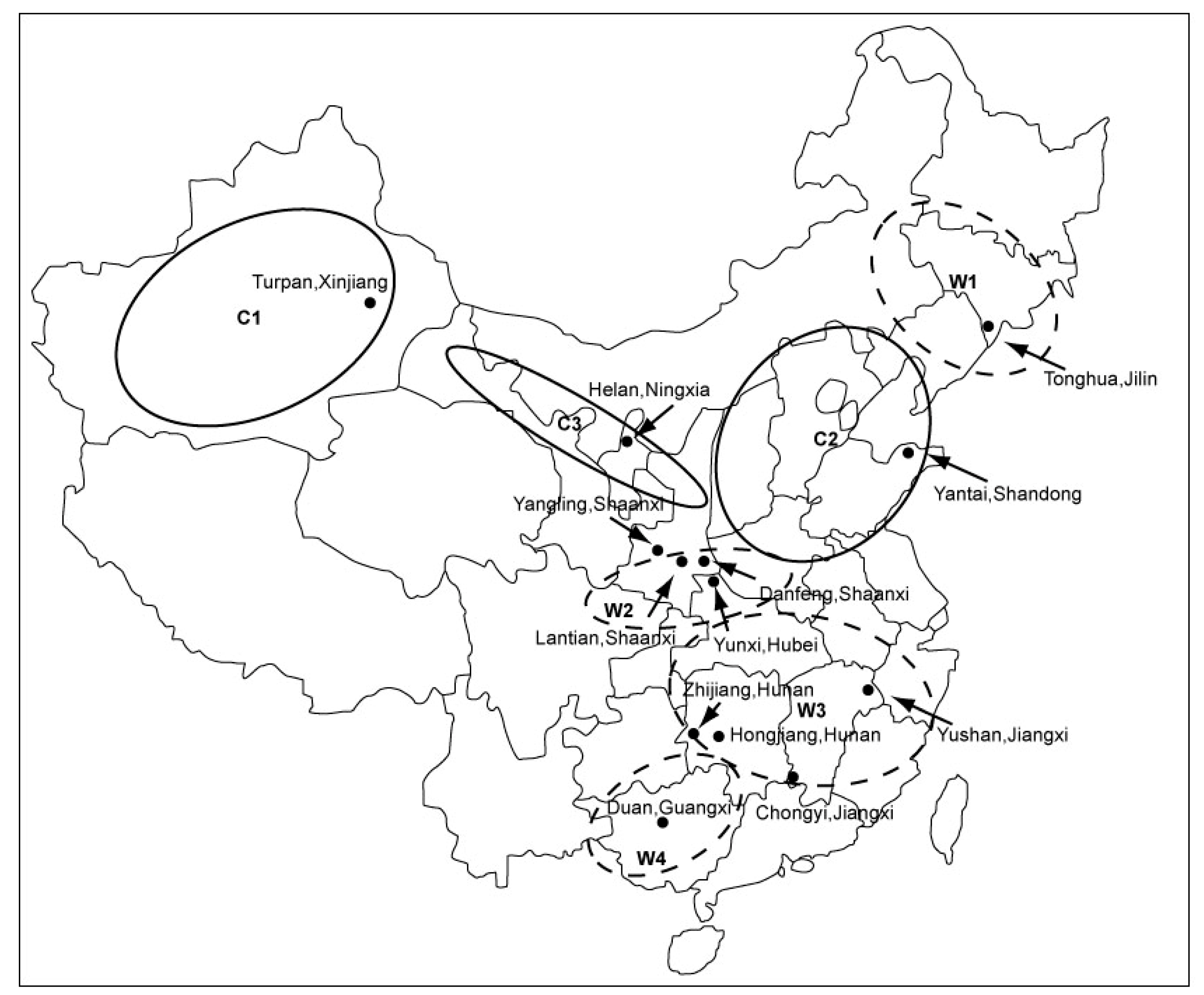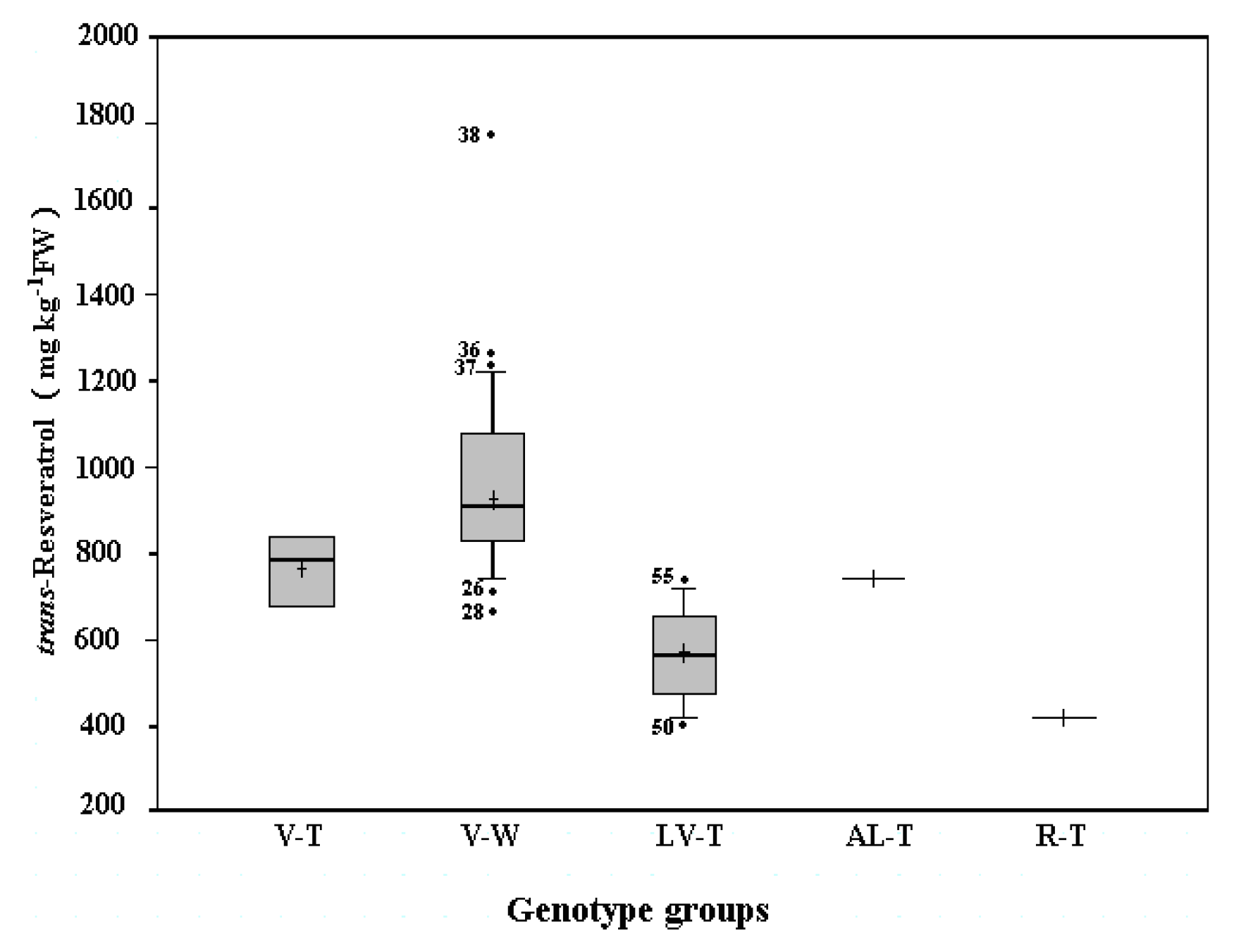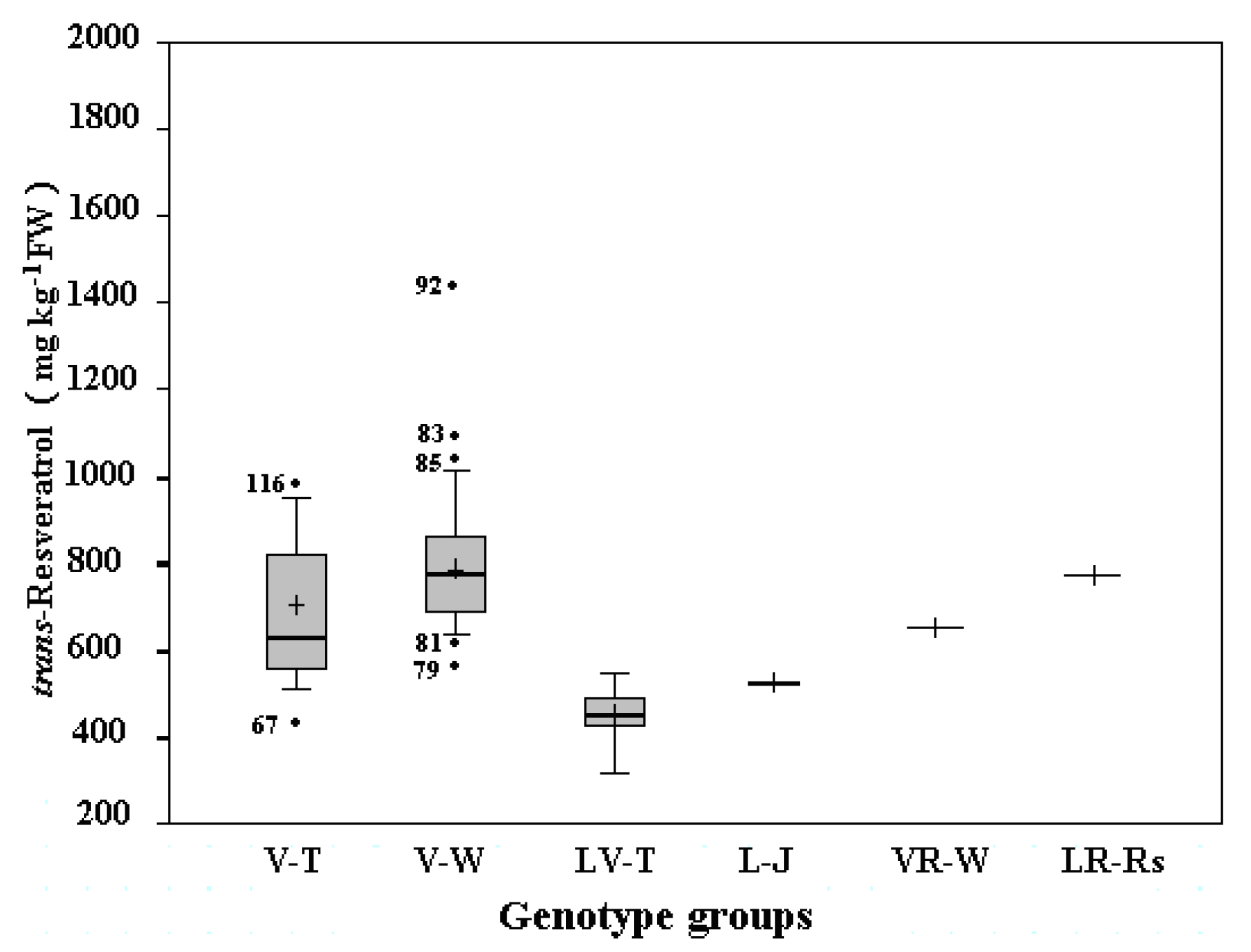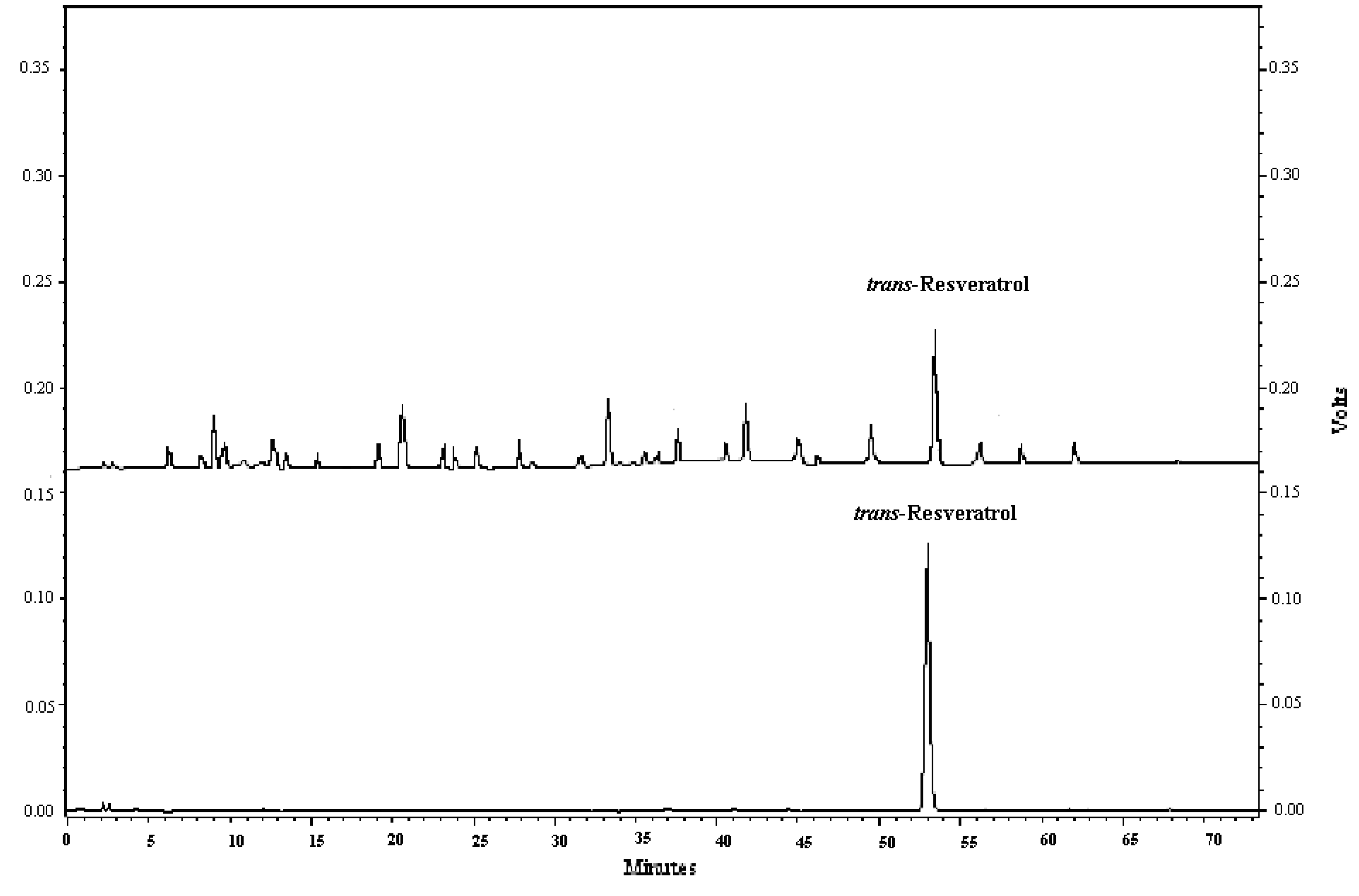Occurrence and Estimation of trans-Resveratrol in One-Year-Old Canes from Seven Major Chinese Grape Producing Regions
Abstract
:1. Introduction

2. Results and Discussion
2.1. Genotypic variation of trans-resveratrol contents in grape canes from two germplasm repertoires


| Locations | Speciesa | Color | Usage | No. | Cultivars or Genotypesc | ||
|---|---|---|---|---|---|---|---|
| Turpan | V | Green | Raisin | 3 | Centennial Seedless (1), Manaizi (2), Thompson Seedless (3) | ||
| Red | Raisin | 4 | Crimson Seedless (4), Monukka (5), Ruby Seedless (6), Munage (7) | ||||
| Helan | V | Green | Wine | 1 | Chardonnay (8) | ||
| Red | Wine | 7 | Cabernet Franc (9), Cabernet Gernischt (10), Cabernet Sauvignon (11), Merlot (12), Syrah (13), Pinot Noir (14), Gamay (15) | ||||
| Yangling | V | Green | Table | 2 | Pearl of Csaba (16), Queen of the Vineyard (17) | ||
| Wine | 15 | Aligoté (18), Angelina (19), Augusta (20), Baibigebuer (21), Baidehai (22), Bourboulenc (23), Chardonnay (24), Ecoly (25), Gouais Blanc (26), Itlian Riesling (27), Müller-Thurgau (28), Petit Manseng (29), Pollux (30), Sauvignon Blanc (31), Semillon (32) | |||||
| Red | Wine | 16 | 8804 (33), Blue French (34), Cabernet Franc (35), Cabernet Gernischt (36), Cabernet Sauvignon (37), Pinot Noir (38), Syrah (39), Gamay (40), Merlot (41), Granoir (42), Gewürztraminer (43), Muscat Hamburg (44), Carignane (45), Cinsaut (46), Zinfandel (47), Roussanne Du Var (48) | ||||
| Table | 1 | Shandongzaohong (49) | |||||
| LV | Green | Table | 2 | Golden Queen (50), Hakuho (51) | |||
| Red | Table | 13 | Beni Zuiho (52), Hutai8 (53), Ikawa1014 (54), Ikawa1025 (55), Iona (56), Izunishiki (57), Kyoho (58), Campbell Early (59), Alirobar (60), Beni Fuji (61), Honey Red (62), Jasmine (63), Tensyu (64) | ||||
| AL | Red | Table | 1 | Conquistador (65) | |||
| R | Red | Table | 1 | Alachua (66) | |||
| Yantai | V | Green | Table | 7 | Victoria Blanc (67), Autumn White (68), Xiabai (69), Zaobai (70), Jingyu (71), Niunai (72), Zexiang (73) | ||
| Wine | 13 | Chardonnay (74), Chenin Blanc (75), Colombard (76), Gamay Blanc (77), Grenache Blanc (78), Jiubai (79), Muscat Blanc (80), Muscat of Alexandria (81), Pinot Blanc (82), Riesling (83), Rkatsiteli (84), Silvaner (85), Ugni Blanc (86) | |||||
| Red | Wine | 20 | Cabernet Franc (87), Cabernet Gernischt (88), Cabernet Sauvignon (89), Gamay (90), Merlot (91), Pinot Noir (92), Syrah (93), Nebbiolo (94), Petit Verdot (95), Pinot Gris (96), Mission (97), Ruby Cabernet (98), Sangiovese (99), Saperavi (100), Noir de Maisky (101), Flame Muscat (102), Alicante Bouschet (103), Yan73 (104), Yan74 (105), Jasmin (106) | ||||
| Table | 14 | Autumn Black (107), Autumn Royal (108), Black Rose (109), Heijixin (110), Jingxiu (111), Guibao (112), Lungyen (113), Manicure Finger (114), Muscat Mathiasz Janosne (115), Fenghuang 51 (116), Hongxiangjiao (117), Rizamat (118), Red Globe (119), Red Guibao (120) | |||||
| LV | Green | Table | 1 | Triumph (121) | |||
| Red | Table | 8 | Fujiminori (122), Jingya (123), Jingyou (124), Meiguilu (125), Olympia Black (126), Takasumi (127), Wase Takasumi (128), Fox (129) | ||||
| L | Green | Juice | 1 | Moore's Diamond (130) | |||
| Red | Juice | 1 | Concord (131) | ||||
| VR | Red | Wine | 1 | Bacco Noir (132) | |||
| LR | Red | Rsb | 1 | Beta (133) | |||
| Lantian | P | Red | Wine§ | 3 | Lantian1 (134), Lantian2 (135), Wangshunshan (136) | ||
| Danfeng | P | Green | Wine§ | 1 | Danfeng2 (137) | ||
| Red | Wine§ | 1 | Danfeng1 (138) | ||||
| Yunxi | P | Red | Wine§ | 3 | Yunxi1 (139), Yunxi2 (140), Yunxi3 (141) | ||
| Duan | P | Red | Wine§ | 3 | Douan1 (142), Douan2 (143), Douan3 (144) | ||
| Zhijiang | D | Red | Wine§ | 3 | Gaoshan-1 (145), Gaoshan-2 (146), Shuijing Brier (147) | ||
| Hongjiang | D | Red | Wine§ | 2 | Xuefengshan1 (148), Xuefengshan2 (149) | ||
| Chongyi | D | Green | Wine§ | 1 | Baiyu (150) | ||
| Red | Wine§ | 4 | Chongyi1 (151), Chongyi2 (152), Chongyi3 (153), Junzi (154) | ||||
| Yushan | D | Red | Wine§ | 1 | Tangwei (155) | ||
| Tonghua | LV | Green | Wine | 1 | Vidal Blanc (156) | ||
| AM | Red | Wine | 5 | Shuanghong (157), Shuangyou (158), Tonghua1 (159), Zuoshan1 (160), Zuoshan2 (161) | |||
| VAM | Red | Wine | 4 | Beichun (162), Beihong (163), Gongniang1 (164), Gongniang2 (165) | |||
| Genotype group or purpose of use | Yangling | Yantai |
|---|---|---|
| All cultivars in this study | 816.0 ± 252.5 | 706.2 ± 191.2 |
| All cultivars of Va | 937.9 ± 210.0***T | 754.9Aa ± 173.4 |
| All cultivars of LVb | 571.3 ± 103.8 | 453.1Bb ± 62.5 |
| All cultivars of Lc | ‒d | 521.9Bb ± 77.1 |
| All wine grapes of V & LV | 950.8 ± 213.7***T | 796.3Aa ± 169.7 |
| All table grapes of V & LV | 610.2 ± 135.9 | 618.9Bb ± 176.7 |
| All juice grape of L | ‒d | 521.9Bb ± 77.1 |
| All red cultivars of V & LV | 843.8 ± 289.7 | 733.4 ± 194.6 |
| All green cultivars of V & LV | 796.9 ± 174.2 | 668..8 ± 187.9 |
| All wine grapes of V | 950.7 ± 213.7*T | 796.3 ± 169.7*T |
| All table grapes of V | 804.6 ± 116.4 | 689.9 ± 160.8 |
2.2. Occurrence and prediction of trans-resveratrol in main grape cultivars from China and comparison with other known sources
| Major region | Usage | Main grape cultivarsa | trans-Resveratrol occurrenceb | Areac | Predicted yieldd | Estimated economic outpute |
|---|---|---|---|---|---|---|
| C1 | Table/ raisin | 1, 2, 3, 4, 5, 6, 7. | 774.0BCbc ± 121.8 (589.9–983.9) | 96.2 | 74.5 (56.7–94.7) | 149.0–223.5 |
| C2 | Wine | 74, 75, 80, 81, 83, 84, 85, 86, 87, 88, 89, 90, 91, 92, 93, 104,105. | 834.1De ± 202.4 (608.9–1452.9) | 48 | 40.0 (29.2–69.7) | 80.0–120.0 |
| Table | 67, 70, 71, 72, 73, 107, 108, 110, 111, 112, 113, 114, 116, 117, 118, 119, 121, 122, 123, 124, 126, 127. | 610.1Aa ± 167.1 (320.6–980.9) | 100.3 | 61.2 (32.2–98.4) | 122.4–183.6 | |
| C3 | Wine | 8, 9, 10, 11, 12, 13, 14, 15, 27, 28, 31, 34, 44, 45, 47. | 937.8CDcd ± 175.7 (763.8–1369.6) | 20 | 18.8 (15.3–27.4) | 37.6–56.4 |
| Table | 16, 17, 49, 50, 51, 52, 53, 57, 58, 59, 61, 64. | 613.3Aa ± 155.4 (396.3–881.9) | 15.9 | 9.8 (6.3–14.0) | 19.6–29.4 | |
| W1 | Wine | 157, 158, 159, 160, 161, 162, 163, 164, 165. | 889.7CDde ± 62.2 (818.7–964.6) | 40 | 35.6 (32.7–38.6) | 71.2–106.8 |
| W2 | Wine§ | 134, 135, 136, 138, 139, 140, 141. | 700.6ABab ± 64.9 (564.6–767.8) | 4.8 | 3.4 (2.7–3.7) | 6.8–10.2 |
| W3 | Wine§ | 145, 146, 147, 148, 150, 151, 152, 154, 155. | 1048.9Ef ± 137.9 (889.8–1285.9) | 19.3 | 20.2 (17.2–24.8) | 40.4–60.6 |
| W4 | Wine§ | 142, 143, 144. | 838.8CDcd ± 30.9 (823.5–850.4) | 10 | 8.4 (8.2–8.5) | 16.8–25.2 |
| Sum.f | 354.5 | 271.9 (200.5–379.8) | 543.8–815.7 |
| Sources | Cultivars or types | trans-Resveratrol | Ref. | ||||
|---|---|---|---|---|---|---|---|
| Polygonum cuspidatum | R. japonica | 64d | [10] | ||||
| R. × bohemica | 23d | ||||||
| R. sachalinensis | 29d | ||||||
| HZ, MB | 3770d, 2960d | [37] | |||||
| Grape juice | Palomino fino | 2.4l | [5] | ||||
| Grape berry | Muscadine | 5.2-26.4f | [42] | ||||
| Grape seed | Gamay | 3.9f | [43] | ||||
| Pinot Noir | 588d | [23] | |||||
| Grape skin | Pinot Noir | 118d | [23] | ||||
| Gamay | 6.8f | [43] | |||||
| Palomino fino | 15.7f | [5] | |||||
| Grape pomace | Palomino fino | 192d | [21] | ||||
| Muscadine | 22.1-84.2d | [42] | |||||
| Red wine | Muscadine | 0.4-2.0l | [42] | ||||
| Other red winea | 0.2-14.3l | [30] | |||||
| White wine | White winesb | ≈ 0.1l | [31] | ||||
| Peanut | Jinpoong | 1.3f | [3] | ||||
| NC-7, Çom, Gazipaşa, Florispan , Çerezlik 5025, Çerezlik PI-355276 | 0.03-1.92d | [44] | |||||
| Other peanut cultivarsc | 0.02-1.79d | [6] | |||||
| Peanut root | Jinpoong | 1.19f | [3] | ||||
| Tainan 9, Tainan 11, Tainan 12 | 15-1330d | [29] | |||||
| Strawberry | Allstar | 0.09f, 0.83d | [8] | ||||
| Blueberry | Highbush Michigan | 0.03f, 0.02d | [7] | ||||
| Lowbush "wild" Nova Scotia | 0.01f, 0.02d | ||||||
| Bilberry | Polish | 0.02f, 0.02d | [7] | ||||
| Pistachio | Ohadi, Uzun, Kırmızı, Halebi, Siirt | 0.09-1.67d | [44] | ||||
| Chocolate | Dark color | 2.0f | [45] | ||||
| Hop | Hop cultivarse | 0.10-2.28d | [9] | ||||
| Hop tg | Tettnang | 13d, 2.7f | [46] | ||||
| Lettucetg | Unknown | 56.4f | [28] | ||||
| Tobaccotg | W38 | 9.3f | [47] | ||||
| Wheattg | Florida, Combi | 35-190f | [48] | ||||
| Oilseed rapetg | Drakkar | 361f | [49] | ||||
| Kiwifruittg | Hayward | 182f | [50] |
3. Experimental
3.1. Plant material
3.2. Chemicals
3.3. Extraction of trans-resveratrol from grape canes
3.4. Chromatographic analysis

3.5. Statistical analysis
4. Conclusions
Acknowledgements
References and Notees
- Cantos, E.; Espin, J.C.; Tomas-Barberan, F.A. Postharvest induction modeling method using UV irradiation pulses for obtaining resveratrol-enriched table grapes: a new “functional” fruit? J. Agric. Food Chem. 2001, 49, 5052–5058. [Google Scholar] [CrossRef]
- Arora, M.K.; Strange, R.N. Phytoalexin accumulation in groundnuts in response to wounding. Plant Sci. 1991, 78, 157–163. [Google Scholar] [CrossRef]
- Chung, I.M.; Park, M.R.; Chun, J.C.; Yun, S.J. Resveratrol accumulation and resveratrol synthase gene expression in response to abiotic stresses and hormones in peanut plants. Plant Sci. 2003, 164, 103–109. [Google Scholar] [CrossRef]
- Valenzano, D.R.; Terzibasi, E.; Genade, T.; Cattaneo, A.; Domenici, L.; Cellerino, A. Resveratrol prolongs lifespan and retards the onset of age-related markers in a short-lived vertebrate. Curr. Biol. 2006, 16, 296–300. [Google Scholar] [CrossRef]
- Roldán, A.; Palacios, V.; Caro, I.; Pérez, L. Resveratrol Content of Palomino fino Grapes: Influence of Vintage and Fungal Infection. J. Agric. Food Chem. 2003, 51, 1464–1468. [Google Scholar] [CrossRef]
- Sanders, T.H.; McMichael, J.R.W.; Hendrix, K.W. Occurrence of resveratrol in edible peanuts. J. Agric. Food Chem. 2000, 48, 1243–1246. [Google Scholar] [CrossRef]
- Lyons, M.M.; Yu, C.; Toma, R.B.; Cho, S.Y.; Reiboldt, W.; Lee, J.; Breemen, R.B. Resveratrol in raw and baked blueberries and bilberries. J. Agric. Food Chem. 2003, 51, 5867–5870. [Google Scholar]
- Wang, S.Y.; Chen, C.; Wang, C.Y.; Chen, P. Resveratrol content in strawberry fruit is affected by preharvest conditions. J. Agric. Food Chem. 2007, 55, 8269–8274. [Google Scholar]
- Jerkovic, V.; Collin, S. Occurrence of resveratrol and piceid in American and European hop cones. J. Agric. Food Chem. 2007, 55, 8754–8758. [Google Scholar] [CrossRef]
- Vrchotová, N.; Šerá, B.; Tříska, J. The stilbene and catechin content of the spring sprouts of Reynoutria species. Acta Chromatogr. 2007, 19, 21–28. [Google Scholar]
- Huang, L.M.; Chen, J.K.; Huang, S.S.; Lee, R.S.; Su, M.J. Cardioprotective effect of resveratrol, a natural antioxidant derived from grapes. Cardiovasc. Res. 2000, 47, 549–555. [Google Scholar] [CrossRef]
- Puissant, A.; Robert, G.; Fenouille, N.; Luciano, F.; Cassuto, J.P.; Raynand, S.; Auberger, P. Resveratrol promotes autophagic cell death in chronic myelogenous leukemia cells via JNK-Mediated p62/SQSTM1 expression and AMPK activation. Cancer Res. 2010, 70, 1042–1052. [Google Scholar] [CrossRef]
- Bertelli, A.A.A.; Das, D.K. Grapes, wines, resveratrols, and heart health. J. Cardiovasc. Pharmacol. 2010, 54, 468–476. [Google Scholar] [CrossRef]
- Norata, G.D.; Marchesi, P.; Passamonti, S.; Pirilloa, A.; Violi, F.; Catapano, A.L. Anti-inflammatory and anti-atherogenic effects of cathechin, caffeic acid and trans-resveratrol in apolipoprotein E deficient mice. Atherosclerosis 2007, 191, 265–271. [Google Scholar] [CrossRef]
- Bertelli, A.A.; Giovannini, L.; Giannessi, D.; Migliori, M.; Bernini, W.; Fregoni, M.; Bertelli, A. Anti-platelet activity of synthetic and natural resveratrol in red wine. Int. J. Tissue React. 1995, 17, 1–3. [Google Scholar]
- Campagna, M.; Rivas, C. Antiviral activity of resveratrol. Boichem. Soc. Trans. 2010, 38 (Pt. 1), 50–53. [Google Scholar]
- Howitz, K.T.; Bitterman, K.J.; Cohen, H.Y.; Lamming, D.W.; Lavu, S.; Wood, J.G.; Zipkin, R.E.; Chung, P.; Kisielewski, A.; Zhang, L.L.; et al. Small molecule activators of sirtuins extend Saccharomyces cerevisiae lifespan. Nature 2003, 425, 191–196. [Google Scholar]
- Li, S.H. Grape production in China. In Grape Production in the Asia-Pacific Region, Proceedings of Viticulture (Grape Production) in Asia and the Pacific, Bangkok, Thailand, 2-4 May 2000; Papademetriou, M.K., Dent, F.J., Eds.; FAO Regional Office for Asia and the Pacific: Bangkok, Thailand, 2001; p. 4.
- Wan, Y.Z.; Schwaninger, H.; Li, D.; Simon, C.J.; Wang, Y.J.; He, P.C. The eco-geographic distribution of wild grape germplasm in China. Vitis 2008, 47, 77–80. [Google Scholar]
- Fang, Y.L.; Wang, H.; Zhang, L.; Chang, W.; Xue, F.; Liu, S.W. Effects of different vinifications on aroma components of wild Vitis quinquangularis red wine. Trans. Chin. Soc. Agric. Eng. 2007, 23, 246–250. [Google Scholar]
- Casas, L.; Mantell, C.; Rodríguez, M.; de la Ossa, E.J.M.; Roldán, A.; Ory, I., De.; Caro, I.; Blandino, A. Extraction of resveratrol from the pomace of Palomino fino grapes by supercritical carbon dioxide. J. Food Eng. 2010, 96, 304–308. [Google Scholar] [CrossRef]
- Karvela, E.; Makris, D.P.; Kalogeropoulos, N.; Karathanos, V.T. Deployment of response surface methodology to optimise recovery of grape (Vitis vinifera) stem polyphenols. Talanta 2009, 79, 1311–1321. [Google Scholar] [CrossRef]
- Casazza, A.A.; Aliakbarian, B.; Mantegna, S.; Cravotto, G.; Perego, P. Extraction of phenolics from Vitis vinifera wastes using non-conventional techniques. J. Food Eng. 2010, 100, 50–55. [Google Scholar] [CrossRef]
- Garg, V.K.; Gupta, R. Vermicomposting of Agro-Industrial Processing Waste. In Biotechnology for Agro-Industrial Residues Utilisation; Nigam, P.S., Pandey, A., Eds.; Springer: Amsterdam, The Netherlands, 2009; pp. 431–432. [Google Scholar]
- Rayne, S.; Karacabey, E.; Mazza, G. Grape cane waste as a source of trans-resveratrol and trans-viniferin: High-value phytochemicals with medicinal and anti-phytopathogenic applications. Ind. Crop Prod. 2008, 27, 335–340. [Google Scholar] [CrossRef]
- Zhang, A.; Fang, Y.L.; Wang, H.; Song, J.Q.; Zhang, Y.L.; Song, S.R. Simultaneous determination of individual phenolics in grape tissues by switching detection wavelength in high performance liquid chromatography. Chin. J. Anal. Chem. 2007, 35, 1614–1618. [Google Scholar]
- Guerrero, R.F.; Puertas, B.; Jiménez, M.J.; Cacho, J.; Cantos-Villar, E. Monitoring the process to obtain red wine enriched in resveratrol and piceatannol without quality loss. Food Chem. 2010, 122, 195–202. [Google Scholar] [CrossRef]
- Liu, S.; Hu, Y.; Wang, X.; Zhong, J.; Lin, Z. High content of resveratrol in lettuce transformed with a stilbene synthase gene of Parthenocissus henryana. J. Agric. Food Chem. 2006, 54, 8082–8085. [Google Scholar]
- Chen, R.S.; Wu, P.L.; Chiou, R.Y.Y. Peanut roots as a source of resveratrol. J. Agric. Food Chem. 2002, 50, 1665–1667. [Google Scholar]
- Stervbo, U.; Vang, O.; Bonnesen, C. A review of the content of the putative chemopreventive phytoalexin resveratrol in red wine. Food Chem. 2007, 101, 449–457. [Google Scholar] [CrossRef]
- Goldberg, D.M.; Yan, J.; Eric, Ng.; Diamandis, E.P.; Karumanchiri, A.; Soleas, G.; Waterhouse, A.L. A global survey of trans-resveratrol concentrations in comercial wines. Am. J. Enol. Viticult. 1995, 46, 159–165. [Google Scholar]
- Langcake, P.; Pryce, J. The production of resveratrol by Vitis vinifera and other members of the Vitaceae as a response to infection or injury. Physiol. Plant Pathol. 1976, 9, 77–86. [Google Scholar] [CrossRef]
- Fang, Y.L.; Zhang, A.; Wang, H.; Li, H.; Zhang, Z.W.; Chen, S.X.; Luan, L.Y. Health risk assessment of trace elements in Chinese raisins produced in Xinjiang province. Food Control 2010, 21, 732–739. [Google Scholar] [CrossRef]
- Wang, J.; Ge, Y.X.; Bao, Y.H. Comparison of characteristics of Vitis amurensis Rupr. varieties. J. Northeast For. Univ. 2004, 32, 29–31. [Google Scholar]
- Peng, H.X.; He, P.C.; Huang, F.X.; Zhu, J.H.; Lin, M.J.; Zhang, Y.; Li, H.L. Comparative studies on the progenies with hermaphrodite flower of the interspecific hybrids of Vitis quinquangularis Rehd. South China Fruits 2005, 24, 52–53. [Google Scholar]
- He, P.C. Wild grape resources and its utilization in China. Sino-Overseas Grapevine Wine 1999, Special Volume, 1–5. [Google Scholar]
- Vastano, B.C.; Chen, Y.; Zhu, N.; Ho, C.T.; Zhou, Z.; Rosen, R.T. Isolation and identification of stilbenes in two varieties of Polygonum cuspidatum. J. Agric. Food Chem. 2000, 48, 253–256. [Google Scholar] [CrossRef]
- USEPA, Compilation of Air Pollutant Emission Factors: AP-42, Stationary Point and Area Sources, 5th ed; United States Environmental Protection Agency: Research Triangle Park, NC, USA, 1995; Volume 1.
- MOA, China’s Agricultural Yearbook of 2006; Ministry of Agriculture (MOA) of the People’s Republic of China: Beijing, China, 2006; p. 192.
- Baur, J.A.; Sinclair, D.A. Therapeutical potential of resveratrol: the in vivo evidence. Nat. Rev. Drug Discov. 2006, 5, 493–506. [Google Scholar] [CrossRef]
- OIV. State of the Vitiviniculture World Market, 2010. Available online: http://news.reseau-concept.net/images/oiv_uk/Client/2010_note_conj_mars_tableaux_EN.pdf. Accessed on 21 July 2010.
- Ector, B.J.; Magee, J.B.; Hegwood, C.P.; Coign, M.J. Resveratrol concentration in Muscadine berries, juice, pomace, purees, seeds and wines. Am. J. Enol. Viticult. 1996, 47, 57–62. [Google Scholar]
- Pezet, R.; Cuenat, P.H. Resveratrol in wine: Extraction from skin during fermentation and post-fermentation standing of must from Gamay grapes. Am. J. Enol. Viticult. 1996, 47, 287–290. [Google Scholar]
- Tokuşoğlu, Ö.; Ünal, M.K.; Yemiş, F. Determination of the phytoalexin resveratrol (3,5,4‘-trihydroxystilbene) in peanuts and pistachios by high-performance liquid chromatographic diode array (HPLC-DAD) and gas chromatography−mass spectrometry (GC-MS). J. Agric. Food Chem. 2005, 32, 5003–5009. [Google Scholar]
- Counet, C.; Callemien, D.; Collin, S. Chocolate and cocoa: New sources of trans-resveratrol and trans-piceid. Food Chem. 2006, 98, 649–657. [Google Scholar] [CrossRef]
- Schwekendiek, A.; Spring, O.; Heyerick, A.; Pickel, B.; Pitsch, N.; Peschke, F.; de Keukeleire, D.; Weber, G. Constitutive expression of a grapevine stilbene synthase gene in transgenic hop (Humulus lupulus L.) yields resveratrol and its derivatives in substantial quantities. J. Agric. Food Chem. 2007, 55, 7002–7009. [Google Scholar]
- Zhong, J.; Liu, S.J.; Ma, S.S.; Yang, W.; Hu, Y.L.; Wu, Q.; Lin, Z.P. Effect of matrix attachment regions on resveratrol production in tobacco with transgene of stilbene synthase from Parthenocissus henryana. Acta Bot. Sin. 2004, 46, 948–954. [Google Scholar]
- Serazetdinova, L.; Oldach, K.H.; Lörz, H. Expression of transgenic stilbene synthases in wheat causes the accumulation of unknown stilbene derivatives with antifungal activity. J. Plant Physiol. 2005, 162, 985–1002. [Google Scholar] [CrossRef]
- Hüsken, A.; Baumert, A.; Milkowski, C.; Becker, H.C.; Strack, D.; Möllers, C. Resveratrol glucoside (Piceid) synthesis in seeds of transgenic oilseed rape (Brassica napus L.). Theor. Appl. Genet. 2005, 111, 1553–1562. [Google Scholar]
- Kobayashi, S.; Ding, C.K.; Nakamura, Y.; Nakajima, I.; Matsumoto, R. Kiwifruits (Actinidia deliciosa) transformed with a Vitis stilbene synthase gene produce piceid (resveratrol-glucoside). Plant Cell Rep. 2000, 19, 904–910. [Google Scholar] [CrossRef]
- Samples Availability: Samples of the extracts of three Chinese wild Vitis species (V. amurensis, V. pentagona, and V. davidii) are available from the authors.
© 2011 by the authors; licensee MDPI, Basel, Switzerland. This article is an open access article distributed under the terms and conditions of the Creative Commons Attribution license ( http://creativecommons.org/licenses/by/3.0/).
Share and Cite
Zhang, A.; Fang, Y.; Li, X.; Meng, J.; Wang, H.; Li, H.; Zhang, Z.; Guo, Z. Occurrence and Estimation of trans-Resveratrol in One-Year-Old Canes from Seven Major Chinese Grape Producing Regions. Molecules 2011, 16, 2846-2861. https://doi.org/10.3390/molecules16042846
Zhang A, Fang Y, Li X, Meng J, Wang H, Li H, Zhang Z, Guo Z. Occurrence and Estimation of trans-Resveratrol in One-Year-Old Canes from Seven Major Chinese Grape Producing Regions. Molecules. 2011; 16(4):2846-2861. https://doi.org/10.3390/molecules16042846
Chicago/Turabian StyleZhang, Ang, Yulin Fang, Xuan Li, Jiangfei Meng, Hua Wang, Hua Li, Zhenwen Zhang, and Zhijun Guo. 2011. "Occurrence and Estimation of trans-Resveratrol in One-Year-Old Canes from Seven Major Chinese Grape Producing Regions" Molecules 16, no. 4: 2846-2861. https://doi.org/10.3390/molecules16042846
APA StyleZhang, A., Fang, Y., Li, X., Meng, J., Wang, H., Li, H., Zhang, Z., & Guo, Z. (2011). Occurrence and Estimation of trans-Resveratrol in One-Year-Old Canes from Seven Major Chinese Grape Producing Regions. Molecules, 16(4), 2846-2861. https://doi.org/10.3390/molecules16042846




